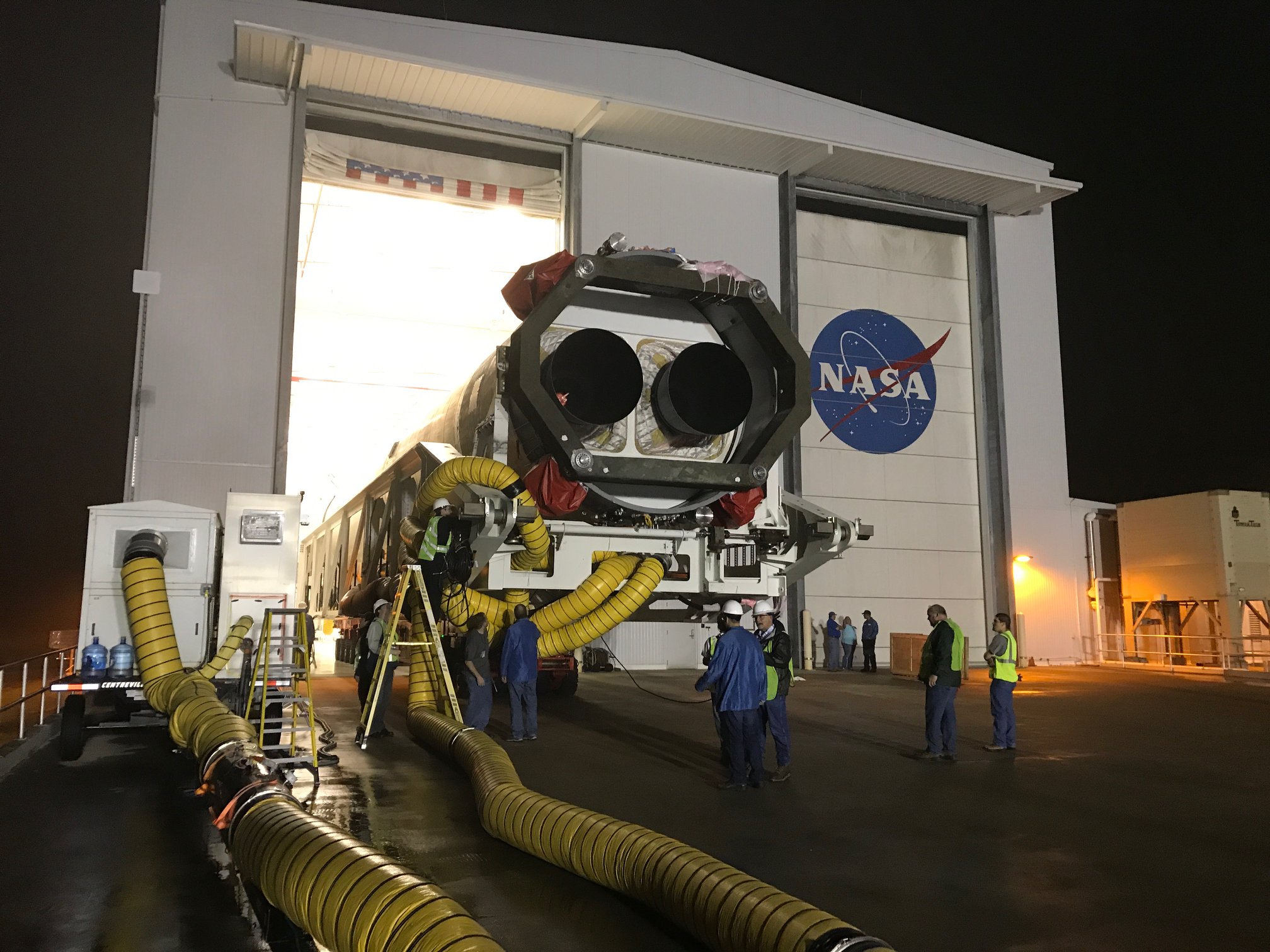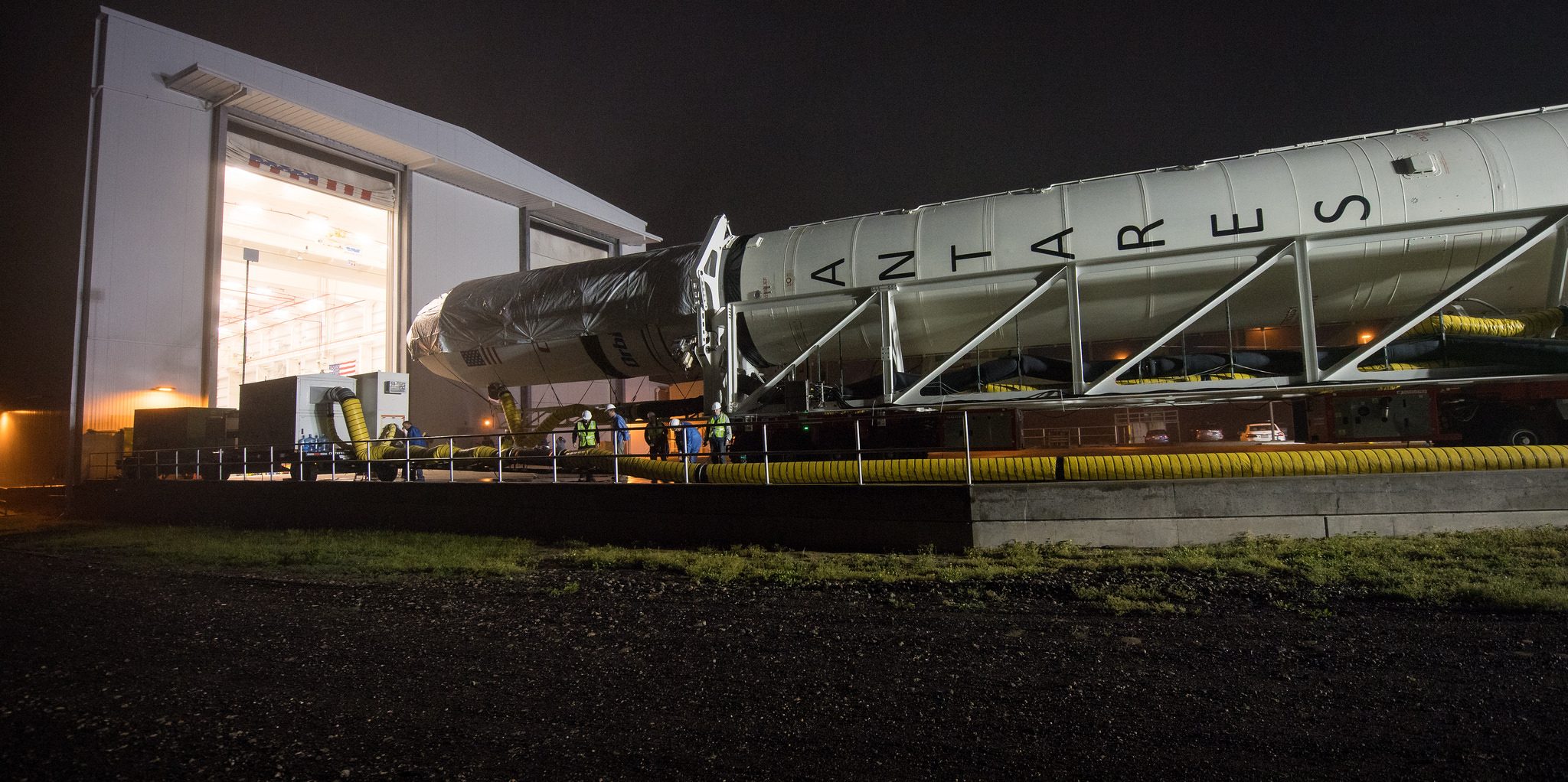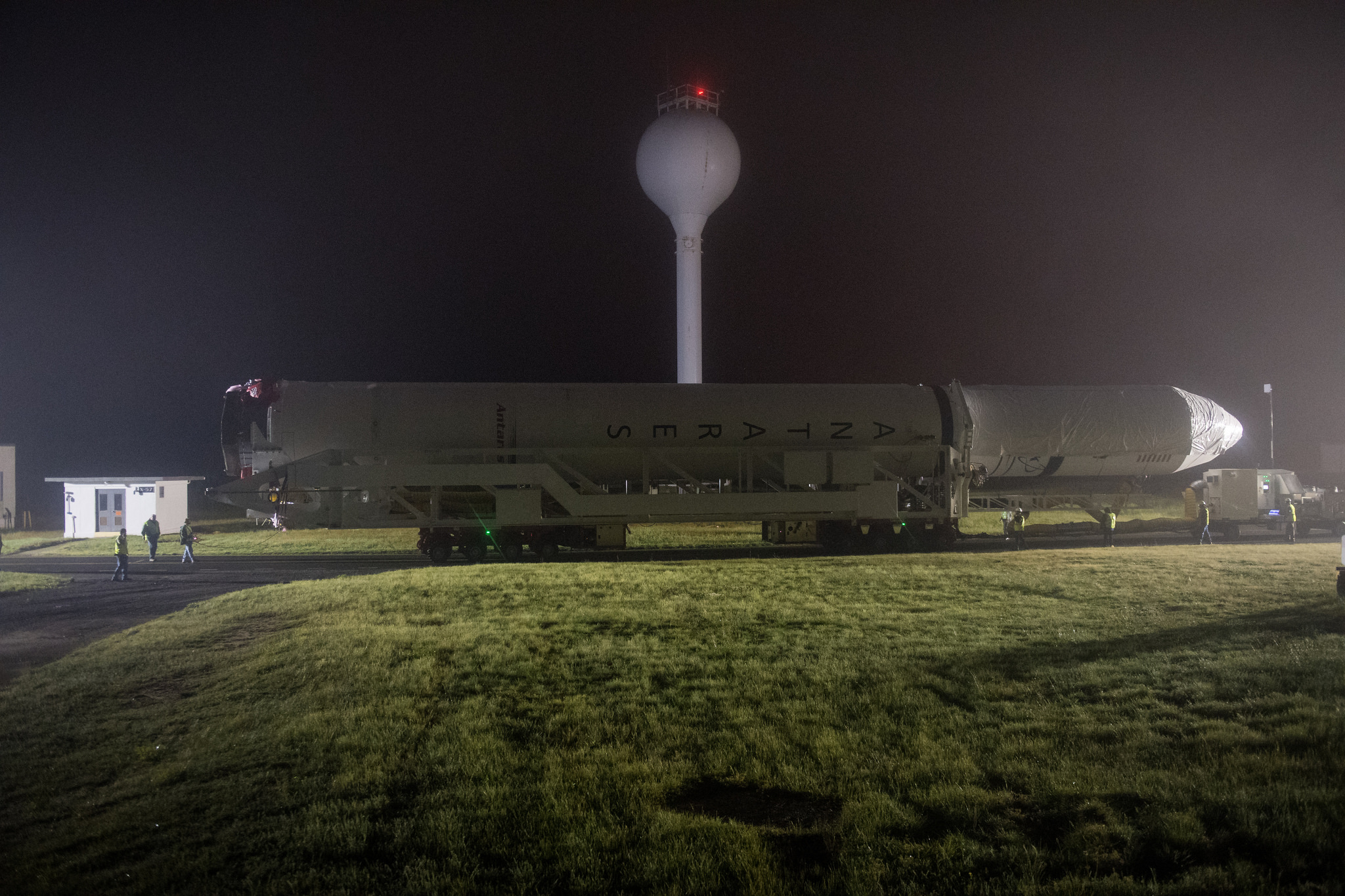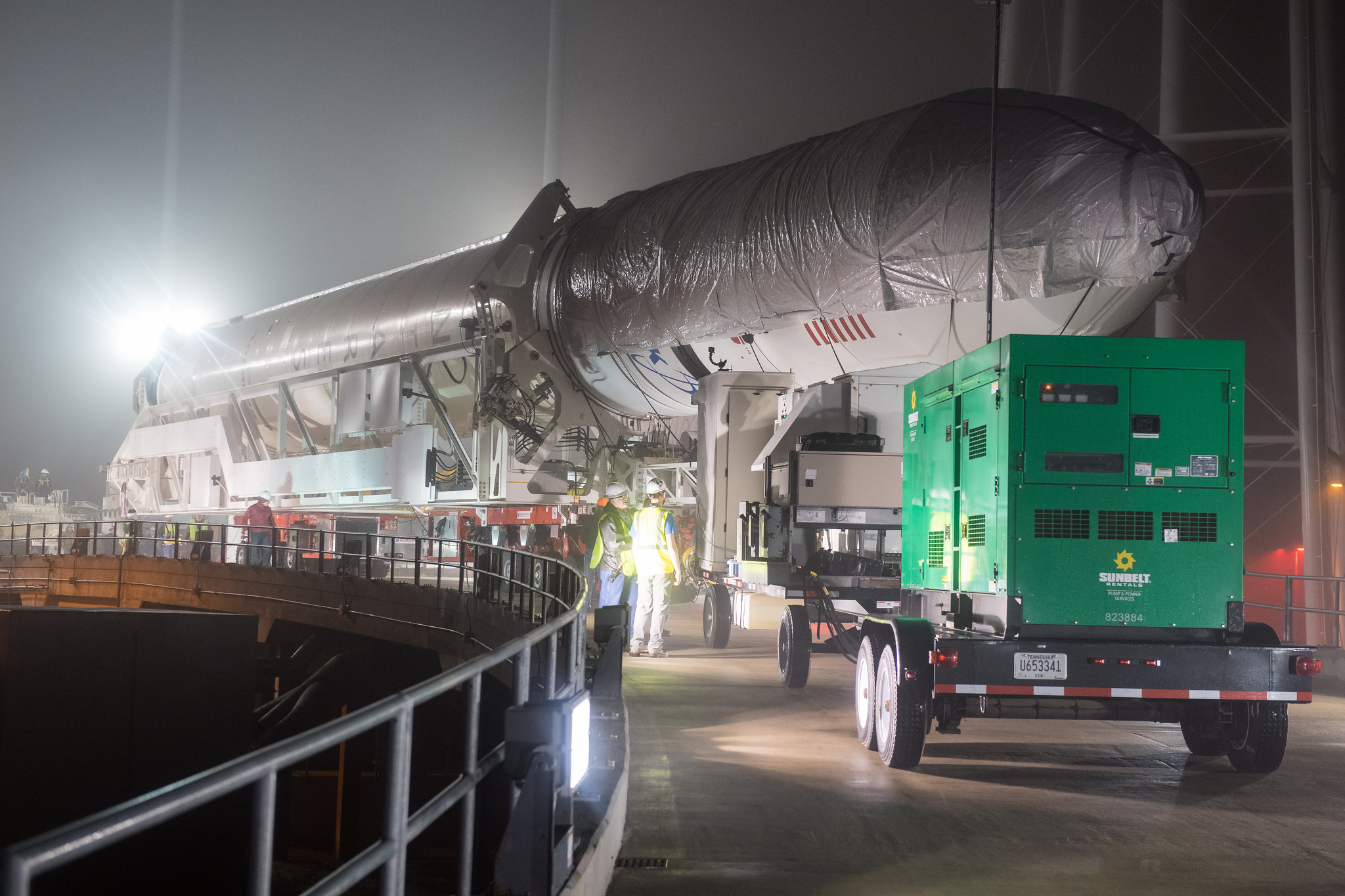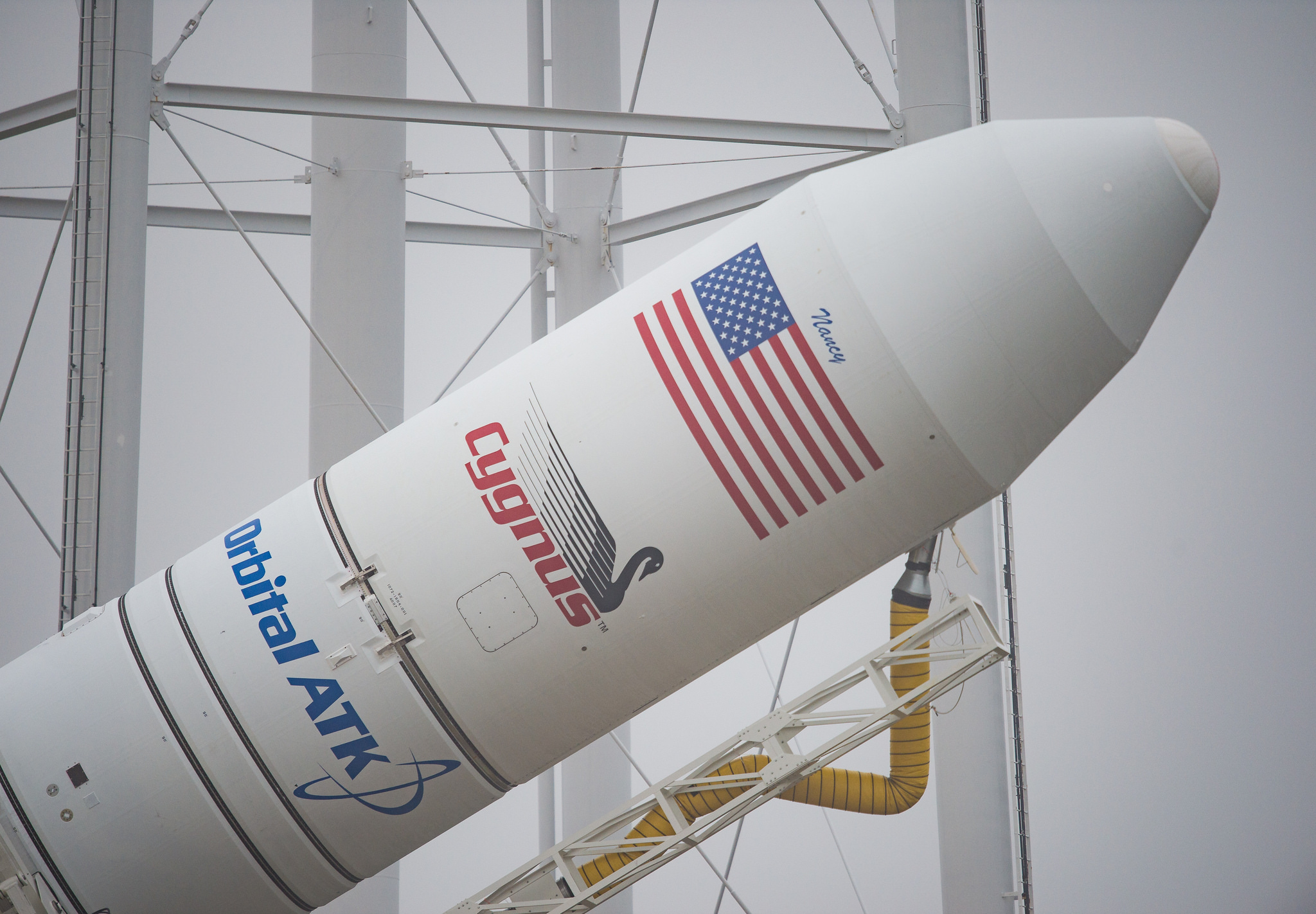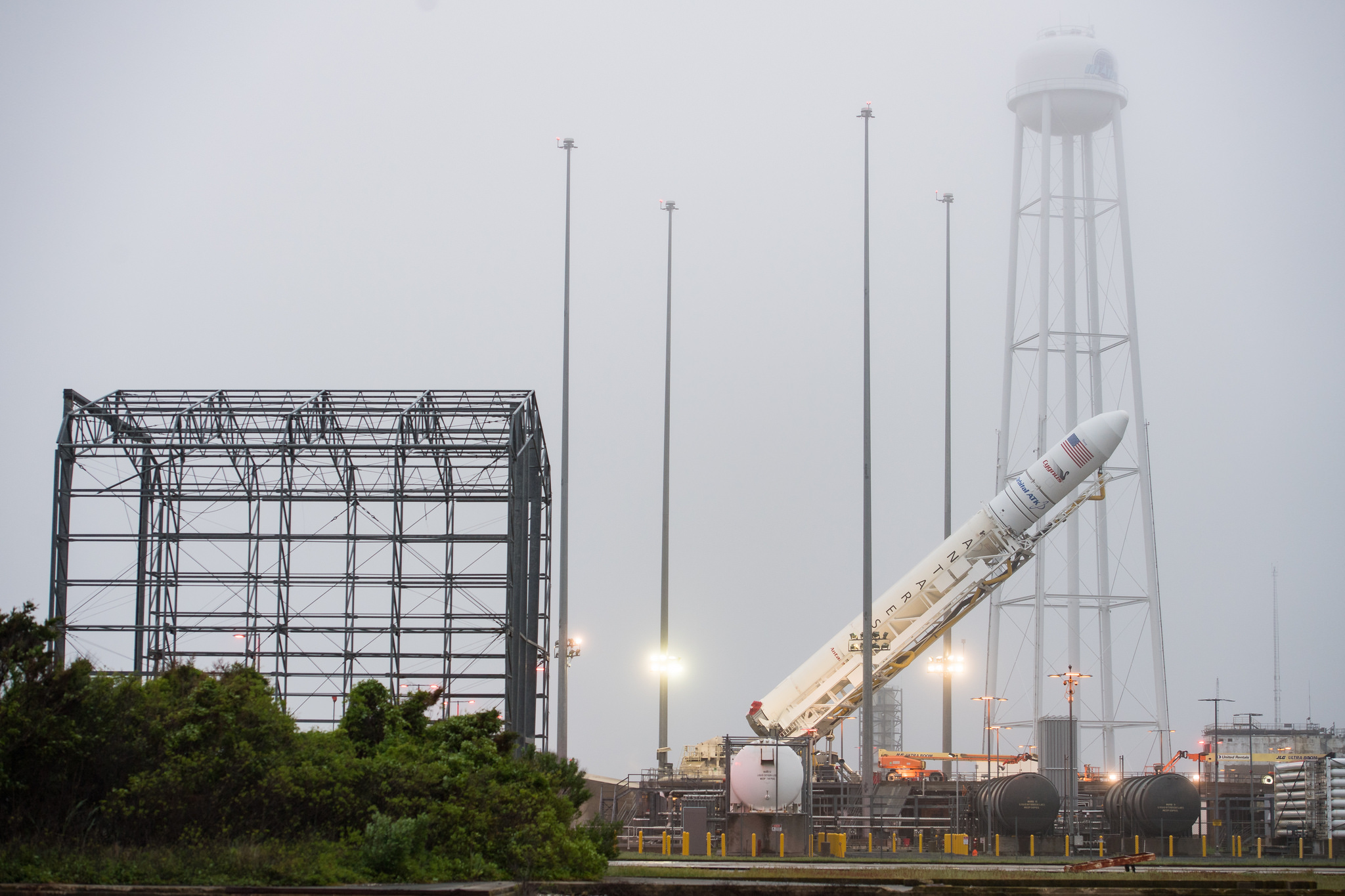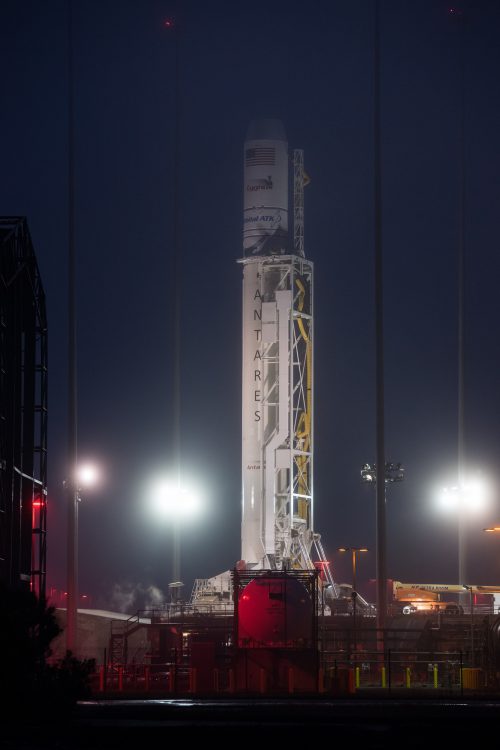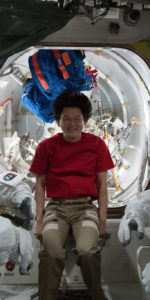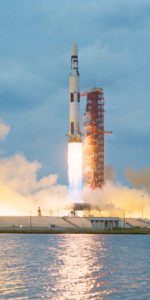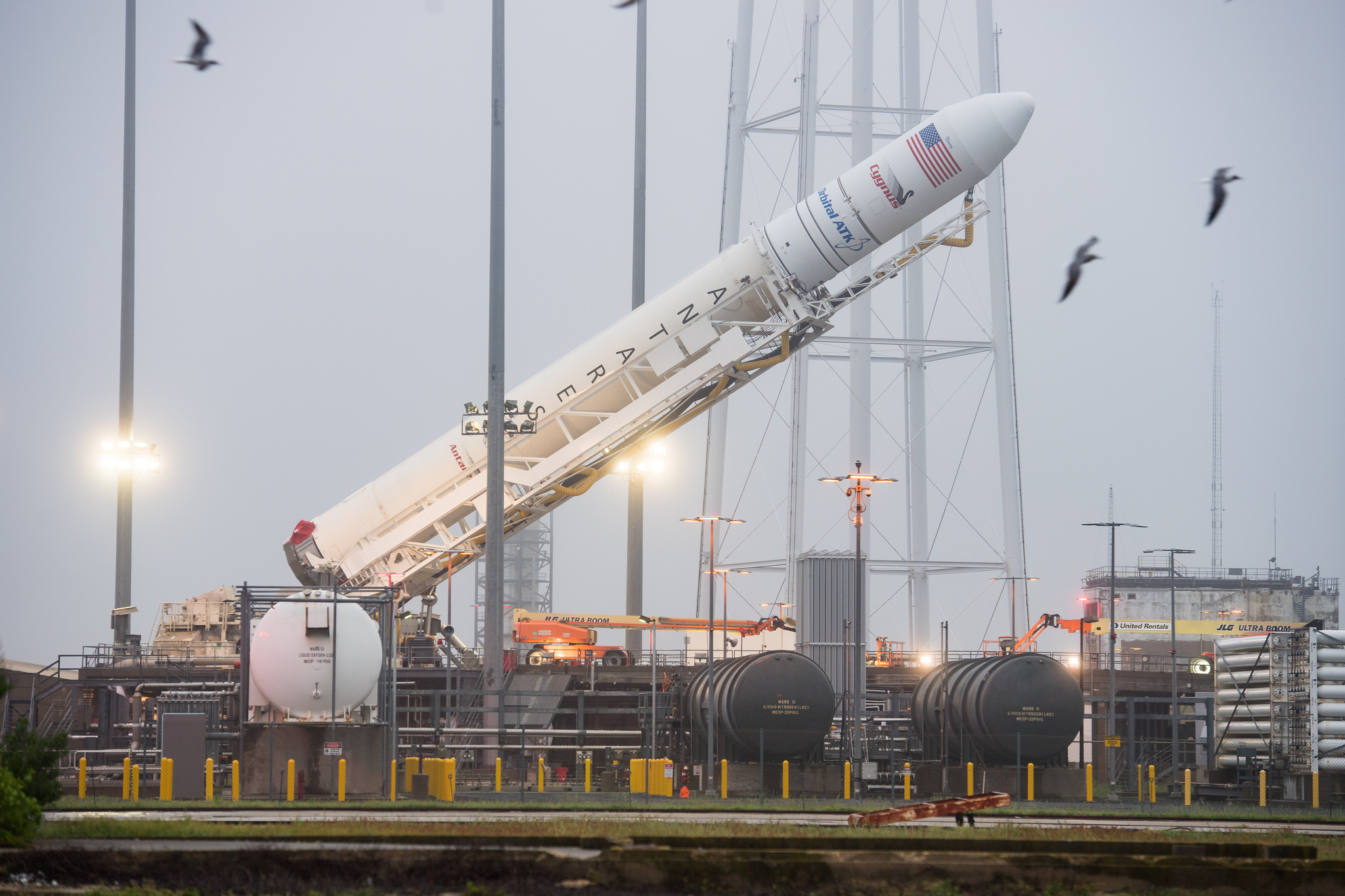
UPDATE May 19 @ 10:00am EDT – Story updated with photos of Antares being raised vertical atop the launch pad in preparation for a launch attempt at 4:39 a.m. EDT Monday morning (8:39am UTC).
UPDATE May 18 @ 12:30pm EDT – Launch has been delayed to NET Monday, May 21st at 4:39 a.m. EDT, “to support further pre-launch inspections and more favorable weather conditions. Monday shows an 80% probability of acceptable weather for launch.”
ORIGINAL STORY – Around 7,400 pounds (3,350 kg) of cargo, payloads and supplies for the incumbent Expedition 55 and upcoming astronaut and cosmonaut crews are due to rocket towards the International Space Station (ISS) on Sunday morning, 20 May, when Orbital ATK lofts its Antares 230 booster from Pad 0A at the Mid-Atlantic Regional Spaceport (MARS) on Wallops Island, Va. Current plans call for the 133-foot-tall (40.5-meter) Antares to launch during a five-minute “window”, which opens at 5:04 a.m. EDT. Designated “OA-9”—for Orbital ATK, which is currently in the final stages of procurement by Northrop Grumman Corp.—Sunday’s mission is the ninth dedicated cargo delivery flight to launch, but actually the tenth overall, when one counts the September 2013 ORB-D “demonstration” mission. Assuming an on-time launch, the Cygnus cargo ship will arrive at the station on Thursday, 24 May, where it will be robotically captured by the 57.7-foot-long (17.6-meter) Canadarm2 and berthed on the Earth-facing (or “nadir”) port of the Harmony node.
FOLLOW OUR LAUNCH TRACKER FOR UPDATES AND LIVE COVERAGE ON LAUNCH DAY!
For the first time, an Orbital ATK Cygnus will honor a non-astronaut on OA-9, which is named for former NASA Deputy Administrator James “J.R.” Thompson. Described by Orbital ATK President and CEO David Thompson as “a distinguished leader in the aerospace industry and an indispensable member of our Orbital ATK leadership team”, the selection of J.R. Thompson continues the Dulles, Va.-based organization’s tradition of honouring “people who have advanced our country’s human spaceflight programs.”
Sunday’s mission is also the eighth launch of Orbital ATK’s Antares booster, which first flew in April 2013, after a long and convoluted development. In its first-generation “100” configuration, which flew five times until October 2014—ending, literally, in a catastrophic explosion, seconds after liftoff—Antares carried a suite of Aerojet Rocketdyne AJ-26 engines, which have since been replaced by a Russian-heritage RD-181 powerplant. This “200”-series of the rocket first saw use in October 2016 and Sunday’s launch will mark its third mission.
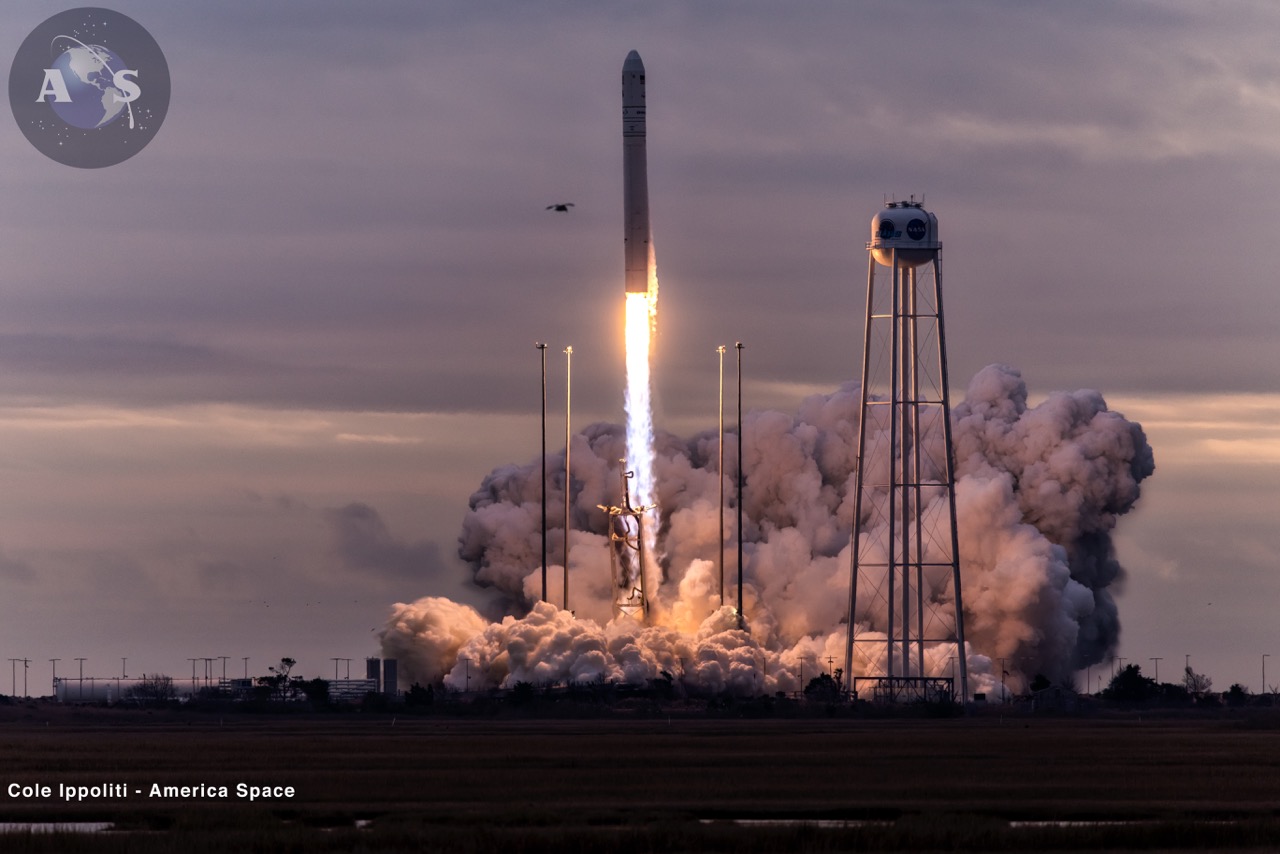
The OA-9 spacecraft is an “Enhanced” variant of the spacecraft, which benefits from a “stretched” Pressurized Cargo Module (PCM), capable of carrying a 60-percent larger haul of payloads and supplies than its predecessor, the Standard Cygnus, which flew until October 2014. Combined with its service module, the upgraded spacecraft stands 15.9 feet (4.86 meters) tall, about 3.9 feet (1.2 meters) higher than its standard predecessor, and although their diameters are the same at 10.1 feet (3.07 meters), the enhanced Cygnus is 4,000 pounds (1,800 kg) more massive and can house a greater payload volume of 950 cubic feet (27 cubic meters). The enhanced spacecraft also carried low-mass Ultraflex solar arrays, whose characteristic fan-like shape makes the entire vehicle distinctive from the wing-like appendages of the standard Cygnus.
OA-9’s payloads are many and varied in their research scope. Final loading took place on Wednesday, 16 May, ahead of Thursday’s rollout to Pad 0A. Rollout came in spite of concerns about rain over the Delmarva Peninsula.
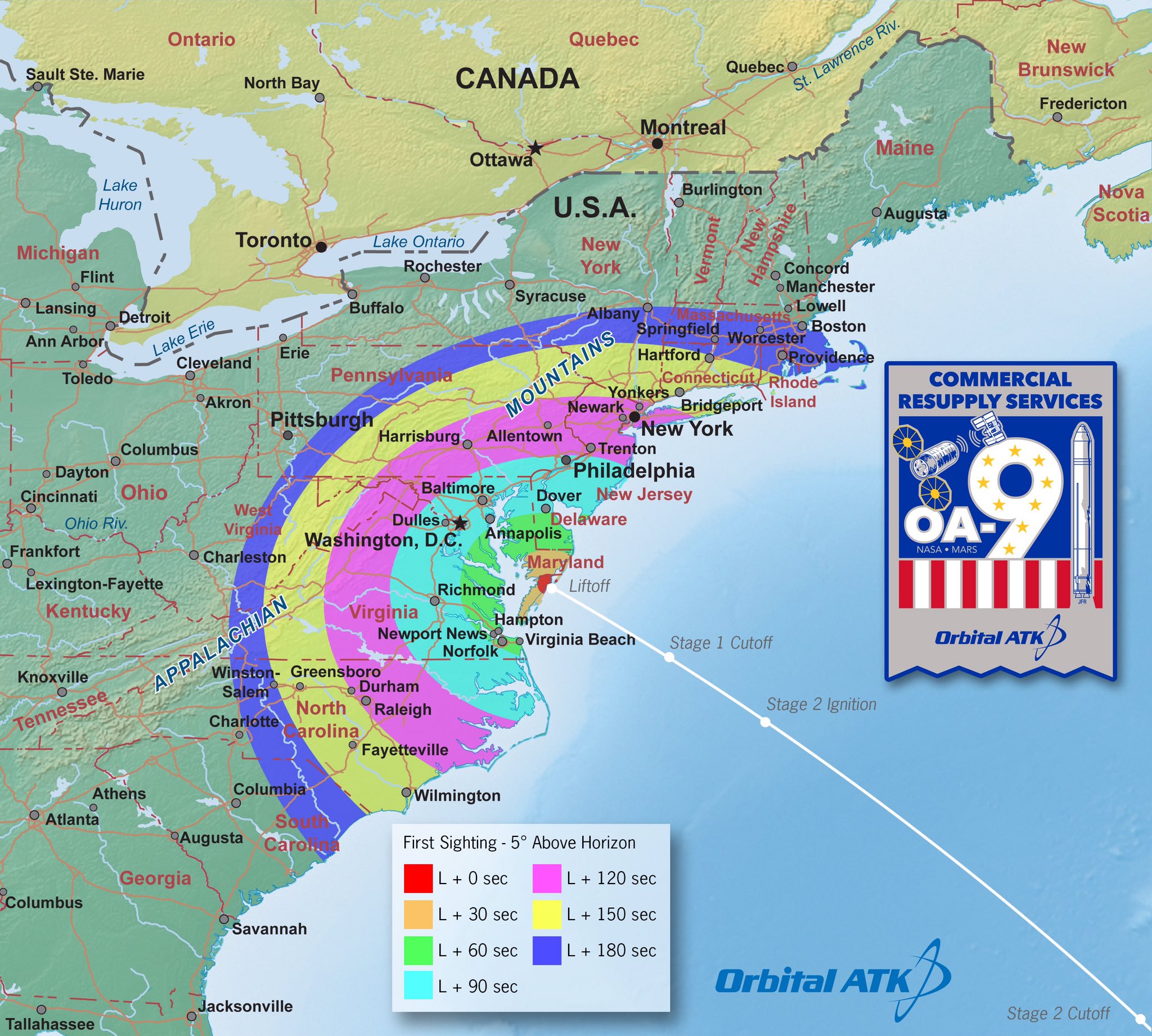
Aboard Cygnus, the Cold Atom Laboratory (CAL) is a multi-user facility to achieve—via laser cooling—and observe ultra-cold quantum gases, as part of efforts to understand atom wave functions and develop future sensors for gravitational and magnetic fields, quantum computers and atomic clocks for spacecraft navigation. The CAL will achieve temperatures ten billion times cooler than the vacuum of space, slowing down atoms with lasers and magnetic forces until they are almost motionless, and examining them for far longer than is possible on Earth. Typically, CAL operations will be conducted during crew sleep, to minimize the potential of microgravity disturbances.
The International Commercial Experiment, nicknamed “ICE Cubes”, will be housed inside the Columbus lab and permit the running of experiments for up to four months at a time. The ICE Cubes units are small, modular containers, about the same size as a microwave oven, which can be easily slotted into payload racks aboard the lab. The Biomolecule Extraction and Sequencing Technology (BEST) investigation will permit the identification and sequencing of unknown microbial organisms aboard the ISS, using a swabs-to-sequencer methodology that eliminates the need for cultivation ahead of processing. And the Continuous Liquid-Liquid Separation in Microgravity experiment will employ surface forces to accomplish liquid-liquid extraction, a process which may find terrestrial benefits to achieve flow-rates suitable for chemical production.
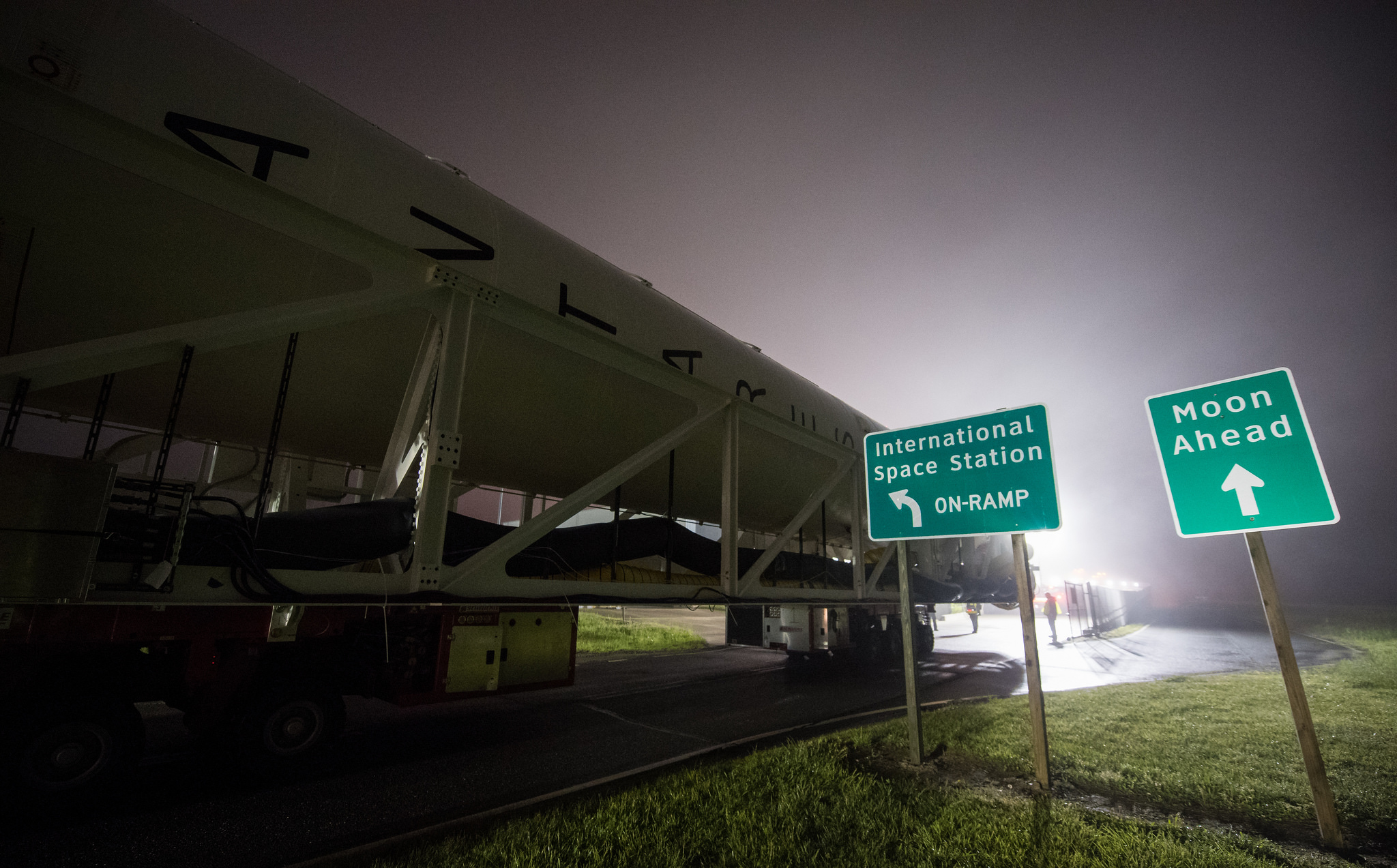
OA-9 will also transport a group of CubeSats uphill in support of Earth science, laser communications and astrophysics research. The Temporal Experiment for Storms and Tropical Systems-Demonstration (TEMPEST-D) will conduct radiometric measurements of global cloud and precipitation processes, as part of efforts to better understand Earth’s water cycle. Another experiment, Radix, seeks to demonstrate technologies for the first commercial optical data-relay system. Likened to NASA’s Tracking and Data Relay Satellite System (TDRSS), “but faster, updated, more flexible and available to commercial clients”, Radix technology is expected to greatly enhance Earth observation and monitoring science for various providers, as well as increasing mission payload utilities. Another CubeSat, dubbed “HaloSat”, wil examine the hot galactic halo of X-rays from oxygen atoms surrounding our Milky Way Galaxy to determine matter quantities.
Assuming an on-time launch on Sunday, Cygnus will arrive in the vicinity of the ISS early Thursday, for capture and berthing by Expedition 55 crewmen Scott Tingle and Ricky Arnold, who will be based at the Canadarm2 controls in the cupola. Monitoring the proceedings and keeping a careful eye on OA-9’s systems will be fellow astronaut Drew Feustel. After berthing, the cargo ship is expected to remain attached to the station for almost two months, with departure currently targeted for 15 July. Unlike SpaceX’s Dragon, the Cygnus is not intended to survive re-entry and will be packed with trash and unneeded equipment for fiery disposal in Earth’s atmosphere.
BELOW: ADDITIONAL PHOTOS (credit: NASA)
FOLLOW AmericaSpace on Facebook!
.





